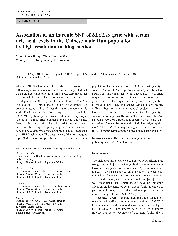摘要
SLC2A9 is a novel identified urate transporter influencing uric acid metabolism. It has been suggested that the single-nucleotide polymorphisms in SLC2A9 may affect the serum UA levels. The present study was designed to investigate rs6855911 polymorphism in intron 7 of SLC2A9 in a total of 372 Chinese male subjects. We examined 166 gout patients, as well as 206 healthy male volunteers in this study. DNA was purified from peripheral blood, and the rs6855911 polymorphism was evaluated using high-resolution melting (HRM) analysis and direct sequencing. Demographic and clinical data obtained from the patients and controls among the genotype groups were analyzed. A/A and A/G genotypes were unambiguously distinguished with HRM technology. The occurrence of the homozygous type (GIG) was completely absent among the study population. The prevalence of the A/A and A/G genotype was 96.0% and 4.0%, respectively. Genotyping based on HRM was fully concordant with sequencing. The G allele frequency was significantly higher in the low-uric-acid group than in the high-uric-acid group. The genotype distribution and allele frequencies were not significantly different between gout and control subjects (p=0.04). However, serum uric acid levels in the A/G genotype subjects were significantly lower than those with the A/A genotypes (p<0.01). Rapid and accurate genotyping analysis of SLC2A9 can be done with HRM. The polymorphism rs6855911 in SLC2A9 may be a genetic marker to assess risk of hyperuricemia among Chinese male Han population.
- 出版日期2011-1
- 单位复旦大学
